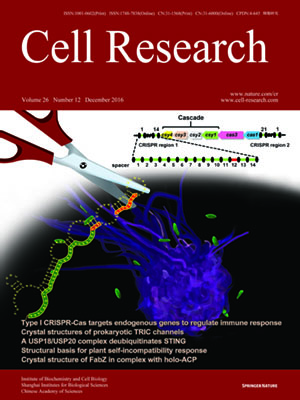
Volume 26, No 12, Dec 2016
ISSN: 1001-0602
EISSN: 1748-7838 2018
impact factor 17.848*
(Clarivate Analytics, 2019)
Volume 26 Issue 12, December 2016: 1320-1329
ORIGINAL ARTICLES
Structural basis for specific self-incompatibility response in Brassica
Rui Ma1, Zhifu Han1, Zehan Hu1, Guangzhong Lin1, Xinqi Gong2, Heqiao Zhang1, June B Nasrallah3 and Jijie Chai1
1Innovation Center for Structural Biology, Tsinghua-Peking Joint Center for Life Sciences, School of Life Sciences, Tsinghua University, Beijing 100084, China
2Institute for Mathematical Sciences, Renmin University of China, 100872
3Section of Plant Biology, 412 Mann Library Building, School of Integrative Plant Science, Cornell University, Ithaca, NY 14853, USA
Correspondence: Jijie Chai, Tel: +86-10-62797718(chaijj@tsinghua.edu.cn)
Self-incompatibility (SI) is a widespread mechanism in flowering plants which prevents self-fertilization and inbreeding. In Brassica, recognition of the highly polymorphic S-locus cysteine-rich protein (SCR; or S-locus protein 11) by the similarly polymorphic S-locus receptor kinase (SRK) dictates the SI specificity. Here, we report the crystal structure of the extracellular domain of SRK9 (eSRK9) in complex with SCR9 from Brassica rapa. SCR9 binding induces eSRK9 homodimerization, forming a 2:2 eSRK:SCR heterotetramer with a shape like the letter “A”. Specific recognition of SCR9 is mediated through three hyper-variable (hv) regions of eSRK9. Each SCR9 simultaneously interacts with hvI and one-half of hvII from one eSRK9 monomer and the other half of hvII from the second eSRK9 monomer, playing a major role in mediating SRK9 homodimerization without involving interaction between the two SCR9 molecules. Single mutations of residues critical for the eSRK9-SCR9 interaction disrupt their binding in vitro. Our study rationalizes a body of data on specific recognition of SCR by SRK and provides a structural template for understanding the co-evolution between SRK and SCR.
10.1038/cr.2016.129
FULL TEXT | PDF
Browse 1800


